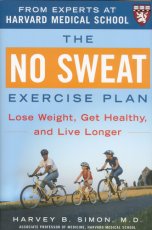 Excerpt
from The No Sweat Exercise Plan: Lose Weight, Get Healthy, and Live Longer
Excerpt
from The No Sweat Exercise Plan: Lose Weight, Get Healthy, and Live Longer
by Harvey B. Simon, M.D.
Climb to Health
Stair-climbing is the best-kept secret in exercise for health. It is a
great way to add CME points during the course of daily life, and it
will help improve your leg strength and balance as well as your heart
and waistline.
By way of example, let me tell you the story of Lewis Ripps. Lew is a trim seventy-two-year-old businessman who runs six and a half miles a day along the hilly Berkshire roads when he is at his Massachusetts vacation home. But heís in Massachusetts only for most summer and autumn weekends and for occasional weekends during the rest of the year. At home in New Jersey, Lew doesnít run -- nor does he swim, bike, use exercise machines, or walk for health.
Mr. Ripps seems to be a weekend warrior who is breaking all the rules. At any age, sporadic intense exercise is a bad idea, and at age seventy-two, itís an invitation for disaster. But Lew is quite safe because he stays active the year round -- not through any formal exercise program, but by walking stairs. And he does quite a lot of that; in fact, he averages eighteen long, steep flights a day at the New Jersey manufacturing plant he manages.
Coaches, cardiologists, and housewives have long been in on the secrets of stairs. Many football coaches ďaskĒ their players to charge up flight after flight of stadium steps to get in shape, and other competitive athletes put gymnasium stairwells to similar use. In the days before stress testing held sway, doctors would often walk up stairs with patients to check their cardiopulmonary function. Even today, cardiologists tell patients they are fit enough to have sex if they can walk up two or three flights comfortably, and surgeons may clear patients for lung operations if they can manage five or six flights. As for housewives, taking care of a two- or three-story home is one reason American women outlive their husbands by an average of 5.4 years.
Whatís so special about stairs? Researchers in Canada answered the question by monitoring seventeen healthy male volunteers with an average age of sixty-four while they walked, lifted weights, or climbed stairs. Stair-climbing was the most demanding. It was twice as taxing as brisk walking on the level and 50 percent harder than walking up a steep incline or lifting weights. And peak exertion was attained much faster by climbing stairs than by walking, which is why nearly everyone huffs and puffs going up stairs, at least until their second wind kicks in after a few flights.
Because stairs are so taxing, only the very young at heart should attempt to charge up long flights. But at a slow, steady pace, stairs can be a health plus for the rest of us. Begin modestly with a flight or two, and then escalate as you improve. Take the stairs whenever you can; if you have a long way to go, walk partway, and then switch to an elevator. Use the railing for balance and security (especially going down), and donít try the stairs after a heavy meal or if you feel unwell.
Even at a slow pace, youíll earn CME points two to three times faster climbing stairs than walking briskly on the level. The Harvard Alumni Study found that men who average at least eight flights a day enjoy a 33 percent lower mortality rate than men who are sedentary -- and thatís even better than the 22 percent lower death rate men earned by walking 1.3 miles a day. That may be a bit optimistic, but even if you donít count on just eight flights a day to keep you healthy, you should add stairs to your CME menu at every opportunity.
Want to stay well? Step right up!
Copyright © 2006 President and Fellows of Harvard College
